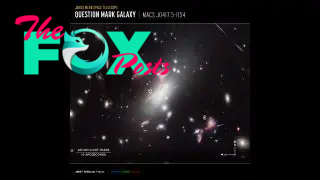Science
What??? James Webb telescope finds giant question mark in space
Since ancient times, humans have looked to the stars for answers to life's biggest questions. Now, new images from the James Webb Space Telescope (JWST) reveal a bizarre cosmic object that appears to be throwing a question of its own right back at us.
Spotted by JWST's Near-Infrared Imager and Slitless Spectrograph instrument, the object in question is a pair of distant galaxies being warped, magnified and multiplied into the shape of a cosmic question mark. Inquisitive aliens are (likely) not responsible — rather, it's caused by a rare form of a common cosmological phenomenon called gravitational lensing, NASA researchers revealed in a statement.
"We know of only three or four occurrences of similar gravitational lens configurations in the observable universe," Guillaume Desprez, an astronomer at Saint Mary's University in Nova Scotia and a member of the team behind the new image, said in the statement. The scarcity of other objects like this one "makes this find exciting," Desprez added, and it speaks to JWST's power to see what prior space telescopes could not.
Gravitational lensing occurs when the gravity of a massive foreground object — such as an enormous galaxy or a cluster of galaxies — bends the light of objects located behind it, relative to our view from Earth. The effect creates a sort of cosmic spyglass, which can not only magnify our view of background objects but also distort and multiply them.
Related: 35 jaw-dropping James Webb Space Telescope images
In this case, a gargantuan galaxy cluster called MACS-J0417.5-1154 is warping and enlarging a pair of tight-knit galaxies located far behind it. The image of the two galaxies is multiplied five times; four copies of the galactic duo are visible in the sinuous body of the question mark, while the fifth drifts off to the lower right side, as noted in the labeled image below. (An unrelated galaxy forms the question mark's lower dot.) This particular formation is known as a "hyperbolic umbilic gravitational lens," according to the researchers.

Located roughly 7 billion light-years from Earth, the lensed galaxies date to when the universe was roughly half its current age, according to NASA. This was a time of rapid star formation, and many galaxies — including our own — were beginning to bulk up and take shape. Seeing them allows astronomers to study what the Milky Way may have looked like eons ago, during its own stellar growth spurt.
-

 Science2d ago
Science2d agoInside Capitol Hill’s Latest UFO Hearings
-

 Science2d ago
Science2d agoYou Won’t Want to Miss the Leonid Meteor Shower. Here’s How and When You Can See It
-

 Science2d ago
Science2d agoHere’s What Trump’s Win Means for NASA
-

 Science6d ago
Science6d agoWhy Risky Wildfire Zones Have Been Increasing Around the World
-

 Science6d ago
Science6d agoIt’s Time to Redefine What a Megafire Is in the Climate Change Era
-

 Science1w ago
Science1w ago4 Astronauts Return to Earth After Being Delayed by Boeing’s Capsule Trouble and Hurricane Milton
-

 Science1w ago
Science1w agoThe Elegance and Awkwardness of NASA’s New Moon Suit, Designed by Axiom and Prada
-

 Science1w ago
Science1w agoSpaceX Launches Its Mega Starship Rocket. This Time, Mechanical Arms Catch It at Landing



























